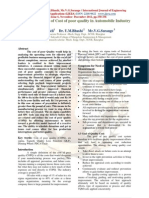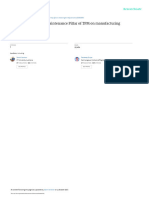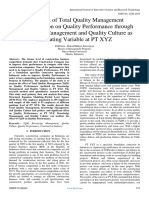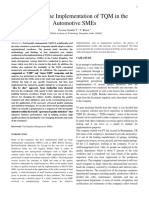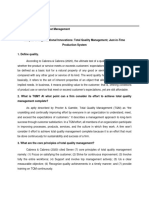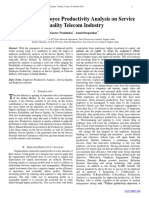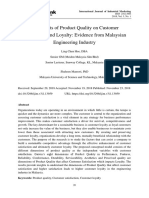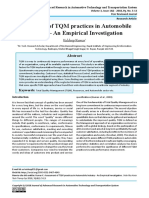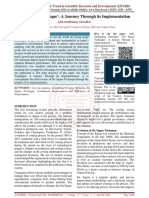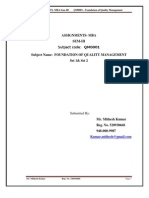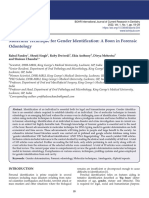Professional Documents
Culture Documents
An Analysis of The Effect of Quality Management System Implementation On Corporate Performance Through Competitive Advantage (A Study at PT. Persada Engineering & Contracting)
Original Title
Copyright
Available Formats
Share this document
Did you find this document useful?
Is this content inappropriate?
Report this DocumentCopyright:
Available Formats
An Analysis of The Effect of Quality Management System Implementation On Corporate Performance Through Competitive Advantage (A Study at PT. Persada Engineering & Contracting)
Copyright:
Available Formats
Volume 5, Issue 11, November – 2020 International Journal of Innovative Science and Research Technology
ISSN No:-2456-2165
An Analysis of the Effect of Quality Management
System Implementation on Corporate Performance
through Competitive Advantage
(A Study at PT. Persada Engineering & Contracting)
Mukhlis *Dudi Permana
MercuBuana University Universitas MercuBuana
Jakarta, Indonesia Jakarta, Indonesia
Abstract:- The globalization paradigm has entered all Keywords:- Customer Focus, Process Management,
aspects of life. The current increased competition is very Quality Assurance, Supplier Focus, Competitive Advantage,
intense, along with changing consumer tastes, socio- and corporate performance.
economic changes and technological advances creating
various business opportunities and challenges. PT I. INTRODUCTION
Persada Engineering & Contracting has not met the
quality performance target as set or has become the The globalization paradigm has entered all aspects of
company standard. The consistent deterioration of the life. The current increased competition is very intense, along
product quality from 2017-2019 shows that the quality with changing consumer tastes, socioeconomic changes, and
management system implementation has not been optimal technological advances, creating various business
in the company. opportunities and challenges. This competition has forced the
company to become the best from other competitors in order
This study aims to examine the effect of customer to survive in the era of globalization. Companies are facing
focus, supplier focus, process management, quality the current phenomenon of not achieving the quality
assurance, competitive advantage on corporate performance targets as established or become the company
performance. As well as to assess the customer focus, standard. The figure below shows the condition for achieving
supplier focus, process management, quality assurance on the quality targets of PT. Persada Engineering & Contracting
corporate performance through competitive advantage. in 2017-2019.
This study adopts a quantitative approach with the type
of explanatory research. The population of this study is the Companies are forced to become the best among other
employees of PT. Persada Engineering & Contracting competitors in order to survive in the era of globalization and
totaling 53 employees. The sample method used an era of intense competition. The company can take ways to
(probability sampling) and the sampling techniques was be the most superior by implementing a good corporate
simple random sampling.Through the Structural strategy, thus it gains competitive advantage. One form of
Equation Model (SEM) approach with measurement strategy that can encourage companies to survive is by
model using the Smart PLS program version 3.2.8. applying an advantage in competition. Gradually, this
competitive advantage is the corporate strategy in obtaining
The results showed that Customer focus has a the final goal efficiently, namely performance that
positive effect on the corporate performance, Supplier createsmaximum profit.
focus has a positive and insignificant effect on the
corporate performance, Process management has a According to Prayhoego and Devie (2018), "So that the
positive effect on the corporateperformance, Quality company to be able to compete and perform well, it can be
assurance has a positive effect on the corporate supported by implementing Total Quality Management
performance, Competitive advantage has a positive effect (TQM), meaning through an integrated approach to obtain
on the corporateperformance, Consumer focus has a and maintain high quality output, focus on maintenance,
positive and insignificant effect on the continuous improvement and failure prevention at all levels
corporateperformance through competitive advantage, and functions of the company, in order to meet or exceed
Supplier focus has a positive and insignificant effect on the consumer expectations." Pt. Persada Engineering &
corporate performance hroughcompetitive advantage, Contracting has not met the quality performance target as set
Process management has a positive and insignificant effect or become the company standard. This is reflected in some
on the corporateperformance through competitive complaints from clients over the results of the service work
advantage, Quality assurance has a positive effect on given and some work that was not completed on time
corporateperformance through competitive advantage.
IJISRT20NOV647 www.ijisrt.com 995
Volume 5, Issue 11, November – 2020 International Journal of Innovative Science and Research Technology
ISSN No:-2456-2165
Figure 1:- Achievement of Quality Targets in 2017 – 2019 B. Competitive Advantage
According to Munizu (2013) "Competitive advantage is
the extent to find out the organization which is able to create
Achievement of Quality Targets
a defensive position over its competitors which includes the
(%)
organization's ability to differentiateitself from its
competitors and is the result of critical management
decisions." The competitive advantage of an organization can
determine the corporate performance. Therefore, the
competitive advantage created by TQM practices should be
able to improve the corporate performance.
C. Quality Management System Implementation
Based on figure 1, the company experienced a Quality Concept
consistent deterioration in product quality from 2017-2019, According to Sahir et.al. (2020:23) "Quality is the level
this indicates that the quality management system of good level or bad of products produced or services
implementation has not been optimal in the company. provided to customers. The highest quality by itself, then this
Furthermore, in connection with the customer complaints, in quality needs to be managed properly." The Quality
picture 2 presented customer complaints of PT. Persada management systems are called total quality management
Engineering & Contracting, as follows: (TQM).
Figure 2:- Customer Complaints Data 2017 – 2019 Research Framework
Costumer Complaints Data Table 1 Research Framework
Customer Focus
(X1)
Supplier Focus
(X2)
Competitive
Advantage (Z) CorporatePerforman
ce
Process
Management
(X3)
It is known that customer complaints graph in 2018 has
increased (8%) from the previous year. It shows that the high
number of customer complaints reflects the quality of service Quality
and support for management has not been implemented Assurance (X4)
effectively and perfectly. From the explanation, the
researchers are interested in conducting research to analyze
the causal relationship between the quality management Hypothesis:
systems implementation, corporate performance and H1 : Consumer focus has a positive effect on corporate
competitive advantage. Thus, the researchers formulated the performance.
title of the study regarding: "An Analysis of the Effect of H2 : Supplier focus has a positive effect on corporate
Quality Management System Implementation on Corporate performance.
Performance through Competitive Advantage (A Study at PT. H3 : Process management has a positive effect on corporate
Persada Engineering & Contracting). performance.
H4 : Quality Assurance has a positive effect on corporate
II. REVIEW OF LITERATURE performance.
H5 : Competitive advantage has a positive effect on
A. Corporate performance corporate performance.
According to Jahanshahi, et al. (2012) "The company's H6 : Consumer focus has a positive effect on corporate
performance is the actual result or output produced by a performance through competitive advantage.
company which is then measured and compared to the H7 : Supplier focus has a positive effect on corporate
expected results or output." Furthermore Aprizal (2018:87) performance through competitive advantage.
states "the purpose of measuring the corporate performance is H8 : Process management has a positive effect on corporate
to find out what the company has successfully achieved in a performance through competitive advantage.
certain period." H9 : Quality assurance has a positive effect on corporate
performance through competitive advantage.
IJISRT20NOV647 www.ijisrt.com 996
Volume 5, Issue 11, November – 2020 International Journal of Innovative Science and Research Technology
ISSN No:-2456-2165
III. RESEARCH METHOD through numbers or questionnaires to be filled in by
respondents, then secondary data is a data collection
The research approach used quantitative with the type technique by collecting literature used to support the primary
of explanatory research which the function is to explain the data. Data analysis used structural equation modeling (SEM)
causal relationship between variables by testing the using the Smart PLS version 3.2.9 program.
hypothesis. The population of this study was the employees
of PT. Persada Engineering & Contracting totaling 53 IV. RESULTS AND DISCUSSION
employees. The sampling method used non-probability
sampling; the samples taken were 53 people. The data in this Validity Test
study are primary and secondary. Obtaining primary data
Table 2 Loading factor Values
Variable Indicator Outer Loading Limit Result
Customer Focus (X1) CF1 0,838 > 0,7 Valid
CF2 0,807 > 0,7 Valid
CF3 0,874 > 0,7 Valid
CF4 0,817 > 0,7 Valid
CF5 0,884 > 0,7 Valid
CF6 0,735 > 0,7 Valid
CF7 0,740 > 0,7 Valid
Supplier Focus (X2) SF1 0,862 > 0,7 Valid
SF2 0,874 > 0,7 Valid
SF3 0,863 > 0,7 Valid
SF4 0,849 > 0,7 Valid
SF5 0,818 > 0,7 Valid
PM1 0,824 > 0,7 Valid
Process Management (X3) PM2 0,842 > 0,7 Valid
PM3 0,847 > 0,7 Valid
PM4 0,816 > 0,7 Valid
Quality Assurance (X4) QA1 0,948 > 0,7 Valid
QA2 0,918 > 0,7 Valid
QA3 0,924 > 0,7 Valid
QA4 0,879 > 0,7 Valid
Corporate Performance (Y) KP1 0,816 > 0,7 Valid
KP2 0,788 > 0,7 Valid
KP3 0,775 > 0,7 Valid
KP4 0,749 > 0,7 Valid
KP5 0,919 > 0,7 Valid
KP6 0,911 > 0,7 Valid
Competitive Advantage (Z) CA1 0,874 > 0,7 Valid
CA2 0,888 > 0,7 Valid
CA3 0,851 > 0,7 Valid
CA4 0,792 > 0,7 Valid
CA5 0,860 > 0,7 Valid
Source: Results of Data Processing with SmartPLS3.2.9 (2020)
The AVE value of the research model for each variable The second stage of validity testing is discriminant
is> 0.5, meaning that the AVE value in the discriminant validity. The following are the results of the discriminant
validity test has been met in the next test. validity of the value of cross-loading between the indicators
and their respective constructs.
IJISRT20NOV647 www.ijisrt.com 997
Volume 5, Issue 11, November – 2020 International Journal of Innovative Science and Research Technology
ISSN No:-2456-2165
Table 4 Cross Loading Value of Each Variable and Research Model Constructions
Supplier Corporate Competitive
Customer Focus Proces Management Quality Assurance
Focus performance Advantage
CA1 0.845 0.845 0.795 0.838 0.853 0.874
CA2 0.816 0.825 0.754 0.858 0.844 0.888
CA3 0.822 0.894 0.823 0.852 0.857 0.851
CA4 0.686 0.711 0.793 0.716 0.785 0.792
CA5 0.766 0.788 0.815 0.785 0.832 0.860
CF1 0.838 0.750 0.791 0.798 0.814 0.789
CF2 0.807 0.675 0.691 0.706 0.728 0.711
CF3 0.874 0.775 0.766 0.834 0.833 0.807
CF4 0.817 0.706 0.772 0.718 0.764 0.726
CF5 0.884 0.862 0.785 0.817 0.838 0.821
CF6 0.735 0.736 0.606 0.692 0.688 0.658
CF7 0.740 0.773 0.670 0.767 0.755 0.743
KP1 0.822 0.798 0.786 0.746 0.816 0.783
KP2 0.748 0.771 0.760 0.793 0.788 0.806
KP3 0.687 0.725 0.815 0.716 0.775 0.799
KP4 0.754 0.763 0.760 0.713 0.749 0.686
KP5 0.853 0.869 0.822 0.897 0.919 0.890
KP6 0.862 0.860 0.807 0.902 0.911 0.884
PM1 0.707 0.706 0.824 0.674 0.764 0.735
PM2 0.832 0.828 0.842 0.769 0.834 0.794
PM3 0.760 0.766 0.847 0.762 0.818 0.841
PM4 0.668 0.818 0.816 0.727 0.758 0.727
QA1 0.879 0.868 0.828 0.948 0.906 0.904
QA2 0.846 0.877 0.806 0.918 0.883 0.858
QA3 0.870 0.878 0.828 0.924 0.888 0.889
QA4 0.843 0.829 0.774 0.879 0.855 0.837
SF1 0.884 0.862 0.785 0.817 0.838 0.821
SF2 0.795 0.874 0.819 0.809 0.839 0.875
SF3 0.766 0.863 0.813 0.794 0.829 0.818
SF4 0.830 0.849 0.767 0.862 0.846 0.822
SF5 0.668 0.818 0.816 0.727 0.758 0.727
Source: Results of Data Processing with SmartPLS 3.2.9 (2020)
Therefore, the conclusion is that all latent constructs Based on the PLS method, the reliability of the
shows the good discriminant validity because they can predict indicators of this study is in accordance with the composite
their block indicators better than other block indicators. reliability and Cronbach's alpha values for each indicator
block. The rule of thumb for alpha or composite reliability
Reliability Test values must be> 0.7 although a value of 0.6 is still acceptable.
Table 5 The Composite Reliability Value of the Research Model
Variable Composite Reliability Limit Result
Customer Focus 0,932 > 0.7 Reliable
Supplier Focus 0,931 > 0.7 Reliable
Process Management 0,900 > 0.7 Reliable
Quality Assurance 0,955 > 0.7 Reliable
Corporate Performance 0,929 > 0.7 Reliable
Competitive Advantage 0,931 > 0.7 Reliable
Source: The Anaysis is usingSmartPLS 3.2.9 (2020)
The composite reliability value of the research model The next reliability test is Cronbach's alpha value test.
shows that each variable already has a composite reliability The construct is declared reliable if it has a Cronbach's alpha
value of> 0.7, meaning that the research model has met the value> 0.60 (Ghozali, 2012).
composite reliability value.
IJISRT20NOV647 www.ijisrt.com 998
Volume 5, Issue 11, November – 2020 International Journal of Innovative Science and Research Technology
ISSN No:-2456-2165
Table 6 Cronbach’s Alpha Value of Research Model
Cronbach’s
Variable Limit Result
Alpha
Customer Focus 0,915 > 0.6 Reliable
Supplier Focus 0,907 > 0.6 Reliable
Process Management 0,852 > 0.6 Reliable
Quality Assurance 0,937 > 0.6 Reliable
Corporate Performance 0,907 > 0.6 Reliable
Competitive Advantage 0,906 > 0.6 Reliable
Source: Results of Data Processing using SmartPLS 3.2.7 (2020)
The Cronbach’s alpha value of the research model Inner model evaluation through the coefficient of
shows that each variable has a Cronbach’s alpha value >0.6 determination is to measure the model capability to explain
which means this model has met the Cronbach’s alpha value. the variance of the dependent variable. The value of the
So, it can be concluded that the model has met the composite coefficient of determination is between 0 and 1. The score of
reliability criteria and Cronbach’s alpha value, meaning that R² is close to 1, meaning how much the hypothesized
this research model has met reliability criteria and reliable independent variable in the equation can relate to the
measuring instrument. dependent variable. The test results are shown in table 7
below:
Determination Test Coefficient / R Square (R2)
Table 7 Scpre R Square (R²) Value of the Research Models
Variable R-Square
Corporate Performance 0,986
Competitive Advantage 0,947
Source: The analysis is using SmartPLS3.2.8 (2020)
The R-square value on the corporate performance (Y) is management, and quality assurance, while the remaining
0,986, which means 98,6% of corporate performance are 5,3% is influenced by other variables.
influenced by customer focus, supplier focus, process
management, quality assurance and competitive advantage. Hypothesis testing
The R-square value on variable competitive advantage (Z) is Hypothesis testing inter-constructs through the
0,947, which means 94,7% of competitive advantage is bootstrap resampling method. By using tools SmartPls 3.2.8
influenced by customer focus, supplier focus, process we can see the value of Path Coefficient, that is the t-statistic
value and the relationship between research variables.
IJISRT20NOV647 www.ijisrt.com 999
Volume 5, Issue 11, November – 2020 International Journal of Innovative Science and Research Technology
ISSN No:-2456-2165
It can be seen more clearly in table table8 :
Table 8 Value of Path Coefficient, t-Statistic, and P-Values
Standard
Original Sample Sample T Statistics P
Dev.
(O) Mean (M) (|O/STDEV|) Value
(STDEV)
Customer Focus -> Corporate
0.164 0.164 0.057 2.872 0.004
Perfomance
Supplier Focus -> Corporate Perfomance 0.022 0.029 0.075 0.295 0.768
Process Management -> Corporate
0.287 0.285 0.082 3.486 0.001
Perfomance
Quality Assurance -> Corporate
0.250 0.248 0.076 3.296 0.001
Perfomance
Competitive Advantage -> Corporate
0.301 0.298 0.103 2.907 0.004
Perfomance
Customer Focus -> Competitive
0.006 0.014 0.033 0.187 0.852
Advantage -> Corporate Perfomance
Supplier Focus -> Competitive Advantage
0.067 0.062 0.056 1.188 0.235
-> Corporate Perfomance
Process Management -> Competitive
0.093 0.096 0.054 1.731 0.084
Advantage -> Corporate Perfomance
Quality Assurance -> Competitive
0.135 0.127 0.062 2.181 0.030
Advantage -> Corporate Perfomance
Source: The Anaysis is using SmartPLS3.2.8 (2020)
The results of the hypothesis by using Smart PLS 3.2.8 Sixth Hypothesis (H6)
can be seen below: The value of t-statistics is 0.187 <the value of t table =
2,012, P-Values = 0.852 > α = 0,05. The coefficient value is
First Hypothesis (H1) 0.006 (positive) it means that consumer focus has a positive
The value of t-statistics is 2.872 > the value of t table = effect for corporate performance 6%.
2,012, P-Values = 0.004 < from α = 0,05. The coefficient
value is 0.164 (positive) it means that customer focus variable Seventh Hypothesis (H7)
has a positive effect for corporate performance 16,4%. The value of t-statistics is 1.188 <the value of t table =
2,012, P-Values = 0.235 > α = 0,05. The coefficient value is
Second Hypothesis (H2) 0.067 (positive) it means that supplier focus has a positive
The value of t-statistics is 0.295 >the value of t table = effect for corporate performance through competitive
2,012, P-Values = 0.768 > α = 0,05. The coefficient value is advantage that is 6,7%.
0.022 (positive) it means that variable supplier focus has a
positive effect for corporate performance 2.2%. Eighth Hypothesis (H8)
The value of t-statistics is 1.731 <the value of t table =
Third Hypothesis (H3) 2,012, P-Values = 0.084 > α = 0,05. The coefficient value is
The value of t-statistics is 3.486 >the value of t table = 0.093 (positive) it means that process management has a
2,012, P-Values = 0.001 < α = 0,05. The coefficient value is positive effect for corporate performance through competitive
0.287 (positive) it means that process management has a advantage that is 9,3%.
positive effect for corporate performance 28,7%.
Ninth Hypothesis (H9)
Fourth Hypothesis (H4) The value of t-statistics is 2.181 >the value of t table =
The value of t-statistics is 3.296 >the value of t table = 2,012, P-Values = 0.030 < α = 0,05. The coefficient value is
2,012, P-Values = 0.001 < α = 0,05. The coefficient value is 0.135 (positive) it means that quality assurance has a positive
0.250 (positive) it means that quality assurance has a positive effect for corporate performance through competitive
effect for corporate performance 25%. advantage that is 13,5%.
Fifth Hypothesis (H5)
The value of t-statistics is 2.907 ><the value of t table =
2,012, P-Values = 0.004 < α = 0,05. The coefficient value is
0.301 (positive) it means that competitive advantage has a
positive effect for corporate performance 30,1%.
V. CONCLUSION
IJISRT20NOV647 www.ijisrt.com 1000
Volume 5, Issue 11, November – 2020 International Journal of Innovative Science and Research Technology
ISSN No:-2456-2165
A. Conclusion [4]. Al-Qudah, Kamal A. M. (2012). The Impact Of Total
According to the results and discussion described Quality Management on Competitive Advantage of
above, the following conclusion can be drawn: Pharmaceutical Manufacturing Companies in Jordan.
1. Customer focus has a positive effect on corporate Perspectives of Innovations, Economics & Business,
performance. Vol. 12, Issue. 3, pp. 59-75.
2. Supplier focushas a positive effect but it has not [5]. Amalia, DevistaAyu., danIsfianadewi, Dessy. (2019).
significant effect on corporate performance. Implementasi Total Quality Management dan
3. Process managementhas a positive effect on corporate Innovation Capability dalamMeningkatkan Quality
performance. Performance. JurnalEkonomi Dan Manajemen, Vol. 3,
4. Quality assurancehas a positive effect on corporate No. 2, hal. 100-113.
performance. [6]. Aprizal. (2018).
5. Competitive advantagehas a positive effect on corporate OrientasiPasardanKeunggulanBersaing
performance. :StudiKasusPenjualanKomputer. Makasar: Celebes
6. Consumer focus has a positive effect but it has not Media Perkasa.
significant effect on corporate performance [7]. Ardestani, Abbas., danAmirzadeh, Yahiya. (2014). The
tthroughcompetitive advantage. Impact Of Total Quality Management Practices On
7. Supplier focus has a positive effect but it has not Innovation Performance and Organizational
significant effect on corporate Performance. Indian Journal of Fundamental and
performancethroughcompetitive advantage. Applied Life, Vol. 4, No. 4, pp. 2050-2057.
8. Process managementhas a positive effect but it has not [8]. Armawaddin, Muhamad. (2011).
significant effect om corporate PengaruhImplementasi Total Quality Management
performancethroughcompetitive advantage. (TQM) TerhadapDayaSaing Dan Kinerja Perusahaan
9. Quality assurancehas a positive effect on corporate Perikanan Di PelabuhanPerikananSamuderaKendari.
performancethroughcompetitive advantage. JurnalIlmiah SiGMA-66, Vol. 1, No. 1, hal. 19-38.
[9]. Emmanuel, Ezenyilimba., Raymond, Ezejiofor.,
B. Suggestions danAfodigbueokwu, Hillary E. (2019). Effect of Total
Quality Management on Organizational Performance of
1. For Management Deposit Money Banks in Nigeria. International Journal
For the company, we suggest to focus more on handling of Business & Law Research, Vol. 7, No. 3, pp. 15-28.
customer complaints and so that they are recorded properly [10]. Fatimah, F., Moelyati, TrisniartyAdjeng.,
and correctly. Because by performing the performance danSyailendra, Siera. (2016). The Impact of Total
according to the standard expected by customer, it will Quality Management Practice on Employees’
maintain the company’s quality. Companies can listen to their Satisfaction and Performance: The Case of Mass
customer expectations and complaints, so that the services Media’s Employees. International Journal of Human
and products that are provided will be satisfied them. Resource Studies, Vol. 6, No. 2, pp. 182-195.
Customer feedback can be a powerful thing to make the [11]. Firman, Ahmad. (2017). Pengaruh Total Quality
company get bigger. Management (TQM)
TerhadapKeunggulanBersaingPada Pt Toyota
2. For the next researchers KallaCabangAlauddin Makassar.
We suggest for the next researchers to add independent JurnalBisnis&Kewirausahaan, Vol. 6, No. 1, hal. 1-16.
variable like internal control system [12]. Ghozali, Imam. (2011). AplikasiAnalisis Multivariate
Dengan Program SPSS. Semarang:
REFERENCES BadanPenerbitUniversitasDiponegoro.
[13]. Hair, J. F., Black, W. C., Babin, B. J., dan Anderson, R.
[1]. Al-Damen, Ali. (2017). The impact of Total Quality E. (2014). Multivariate Data Analysis: A Global
Management on organizational performance Case of Perspective (7th ed.). New Jersey: Pearson Education,
Jordan Oil Petroleum Company. International Journal Inc.
of Business and Social Science, Vol. 8, No. 1, pp. 192- [14]. Heizer, Jay., dan Render, Barry. (2015). Operation
202. Management. Edisi 11. Jakarta: PenerbitSalembaEmpat.
[2]. Al-Dhaafri, Hassan Saleh., dan Al-Swidi, Abdullah. [15]. Jahanshahi, A. A., Rezaie, M., Nawaser, K., Ranjbar,
(2016). The impact of Total Quality Management and V., & Pitamber, B. K. (2012). Analyzing the Effect of
Entrepreneurial Orientation on Organizational Electronic Commerce on Organizational Performance :
Performance. International Journal of Quality & Evidence from Small and Medium Enterprises. African
Reliability Management, Vol. 33, Issue. 5, pp. 1-20. Journal of Business Management, Vol. 6, No. 15, pp.
[3]. Al-Qahtani, Norah Dhafer., Alshehri, Sabah Sa'ad., 6486- 6496.
danAbd.Aziz, Azrilah. (2015). The impact of Total [16]. Juharni. (2017). ManajemenMutuTerpadu (Total
Quality Management on Organizational Performance. Quality Management). Makassar : CV Sah Media.
European Journal of Business and Management, Vol. 7,
No. 36, pp. 119-127.
IJISRT20NOV647 www.ijisrt.com 1001
Volume 5, Issue 11, November – 2020 International Journal of Innovative Science and Research Technology
ISSN No:-2456-2165
[17]. Kaynak, Hale. (2015). The Relationship Between Total [29]. Pambreni, Yuni., Khatibi, Ali., Azam, S. M. Ferdous.,
Quality Management Practices and Their Effects on danTham, Jacquline. (2019). The Influence Of Total
Firm Performance. Journal of Operations Management, Quality Management Toward Organization
Vol. 21, No. 4. Performance. Journal Management Science Letters,
[18]. Kumala, NindiyaSidha., danWidyarti, Heni. (2020). Vol. 9, pp. 1397-1406.
PengaruhPenerapan Total Quality Management [30]. Pham, Thi My Dung. (2020). On The Relationship
TerhadapKinerjaKeuanganDenganSistemPengukuranKi Between Total Quality Management Practices and Firm
nerjaSebagaiVariabelModerasiPada CV MutiaraAbadi Performance in Vietnam: The Mediating Role of Non-
Semarang. Financial Performance. Journal Management Science
JurnalAktualAkuntansiKeuanganBisnisTerapan, Vol. 3, Letters, Vol. 10, pp. 1743-1754.
No. 1, hal. 1-16. [31]. Pratama, Abdul Aziz Nugraha., danMaghfiroh, FiraNur.
[19]. Laiya, Randi Abdul Rizal., Jan, Arrazi Hasan., (2016). Pengaruh Total Quality Management (TQM)
danPondaag, Jessy. Pengaruh Total Quality terhadapKinerjaKaryawan di BMT TarunaSejahtera
Management (Tqm) TerhadapKinerjaManajerialPada Ungaran, Jawa Tengah. JurnalMuqtasid, Vol. 7, No. 1,
PT. Bank Mandiri (Persero) Tbk Area Manado. Jurnal hal. 93-117.
EMBA, Vol. 6, No. 4, hal. 2658-2667. [32]. Prayhoego, Callystha., danDevie. (2018).
[20]. Mahfiza. (2019). PengaruhImplementasi Total Quality AnalisaPengaruh Total Quality Management
Management TerhadapKinerjaKaryawan (StudiPada TerhadapKeunggulanBersaingdanKinerja Perusahaan.
PT. PLN (Persero) Cabang Gorontalo). JurnalEkonomi Business Accounting Review, Vol. 1, hal. 1-11.
Islam, Vol. 15, No. 1, hal. 43-54. [33]. Rahman, FajriZiha. (2011). PengaruhPenerapan Total
[21]. Mambanda, John., Maibvisira, Gabriel., danMurangwa, Quality Management (TQM) Serta
Stanley Idanai. (2017). Effects of Total Quality PengaruhnyaTerhadapKinerjaPelayananIslamidanKep
Management on the Performance of the Food and uasanKonsumen. Institut Agama Islam Walisongo.
Beverages Industry in Zimbabwe. International Journal Semarang.
of Business and Management Invention, Vol. 6, Issue. 6, [34]. Sadikoglu, Esin., danHilal, Olcay. (2014). The Effect of
pp. 26-36. Total Quality Management Practices on Performance
[22]. Manurung, Mona Tiorina., Sugiarto, Johanes., and the Reasons of and the Barriers to TQM Practices in
danMunas, Bambang. (2016). Turkey”. Hindawi Publishing Advances in Decision
MembangunKeunggulanBersaingUntukMeningkatkanK Sciences., 17 pages. Gebze Institute of Technology
inerjaBisnisPadaIndustri Kecil MenengahTenunIkat Di Kocaeli, Turkey.
Troso, Jepara. JurnalBisnisStrategi, Vol. 25, No. 2, hal. [35]. Sahir, SyafridaHafni., Hasibuan, Abdurrozzaq., Aisyah,
171-184. Siti., Sudirman, Acai., Kusuma, Aditya Halim Perdana.,
[23]. Mosadeghrad, Ali Mohammad. (2015). Developing and Salmiah., Salmiah., Afriany, Joli., Simarmata, Janner.
Validating a Total Quality Management Model for (2020). GagasanManajemen. Medan: Yayasan Kita
Healthcare Organisation. The TQM Journal. Vol. 27, Menulis.
No. 5, pp. 544-564. [36]. Sayyad, Nermeen. (2017). The Relationship between
[24]. Munizu, Musran. (2013). The Effect of TQM Practices Total Quality Management Practices and Their Effects
on Corporate Performance and Competitive Advantage on Firms Performance in Palestine. Business &
as Mediating Variable: Study at Manufacturing Entrepreneurship Journal, Vol. 6, No. 2, pp. 35-51.
Companies in Makassar, South Sulawesi Province. [37]. Shafiq, Muhammad., Lasrado, Flevy., danHafeez,
JurnalManajemenTeknologi, Vol. 12, No. 2, pp. 207- Khalid. (2019). The Effect of TQM on Organisational
219. Performance: Empirical Evidence From The Textile
[25]. Nasution, M. (2015). ManajemenMutuTerpadu. Bogor: Sector of a Developing Country Using SEM. Total
Ghalia Indonesia. Quality Management and Business Excellence, Vol. 30,
[26]. Ngambi, Marcel T., danNkemkiafu, AyankengGodlove. No. 1-2, pp. 31-52.
(2015). The Impact of Total Quality Management on [38]. Shan, Ang Wei., Ahmad, MohdFauzi., danNor, Nik
Firm’s Organizational Performance. American Journal HisyamudinMuhd. (2016). The Mediating Effect of
of Management, Vol. 15, No. 4, pp. 69-85. Innovation between Total Quality Management (TQM)
[27]. Novianty, Vania. (2019). AnalisisPengaruhFaktor – and Business Performance. International Engineering
Faktor Total Quality Management (TQM) Research and Innovation Symposium, Vol. 160, pp. 1-9.
TerhadapKinerja Perusahaan PT XYZ. [39]. Singh, Vedant., Kumar, Akshay., dan Singh, Tej.
JurnalManajemenBisnis Dan Kewirausahaan, Vol. 3, (2018). Impact of TQM on Organisational Performance:
No. 3, hal. 54-61. The Case of Indian Manufacturing and Service Industry.
[28]. Ozdal, MacideArtac., danOyebamiji, Bamise Faith. Operations Research Perspectives, pp. 1-47.
(2018). Implementation of Total Quality Management [40]. Siregar, Syofian. (2013). MetodePenelitianKuantitatif.
and its Effect on Employees’ Performance in a Jakarta: PT Fajar. InterpratamaMandiri.
Teaching Hospital in Oyo State, Nigeria. Public Health
Open Access, Vol. 2, Issue. 3, pp. 1-8.
IJISRT20NOV647 www.ijisrt.com 1002
Volume 5, Issue 11, November – 2020 International Journal of Innovative Science and Research Technology
ISSN No:-2456-2165
[41]. Suartina, I Wayan., Swara, Ni
NyomanAdityariniAbiyoga Vena., danAstiti, Ni Luh
Sri. (2019). Pengaruh Total Quality Management (Tqm)
TerhadapKinerja Perusahaan
MelaluiPerilakuProduktifKaryawanPada PT.
Tomorrow’s Antiques Indonesia.
JurnalWidyaManajemen, Vol. 1, No. 2, hal. 1-20.
[42]. Sugiyono. (2016). MetodePenelitianKuantitatif,
Kualitatifdan R&D. Bandung: PT Alfabet.
[43]. Sukardi, Ria Amalia. (2016). Pengaruh Total Quality
Management (TQM)
TerhadapKepuasanPelangganPadaMatahari Department
Store di Plaza MuliaSamarinda.
eJournalAdministrasiBisnis, Vol. 4, No. 3, hal. 758-
772.
[44]. Suyitno. (2016).
PeningkatanSumberdayaManusiaMelaluiPenerapan
Total Quality Management. JurnalAkuntansi,
EkonomidanManajemenBisnis, Vol. 4, No. 2, hal. 150-
157.
[45]. Zulkarnain, I., Gemina, D., danYuningsih, E. (2019).
Pengaruh Total Quality Management
TerhadapKinerjaKaryawan PT BCD Bogor.
JurnalSosialHumaniora, Vol. 10, No. 1, hal. 40-48.
IJISRT20NOV647 www.ijisrt.com 1003
You might also like
- 9 Ws of ActingDocument7 pages9 Ws of ActingNihar KambleNo ratings yet
- Failure Case Studies in Civil EngineeringDocument135 pagesFailure Case Studies in Civil Engineeringpratip_b100% (2)
- Atmosphere Lesson PlanDocument7 pagesAtmosphere Lesson PlanJasmine DanaNo ratings yet
- Marriage Builders Emotional Needs Questionnaire PDFDocument12 pagesMarriage Builders Emotional Needs Questionnaire PDFPrarthanaRavikumarNo ratings yet
- Cost of Poor Quality 1Document7 pagesCost of Poor Quality 1Shavin AvinNo ratings yet
- REVIEW INNOVATIONS CE BOARD EXAMDocument3 pagesREVIEW INNOVATIONS CE BOARD EXAMKian Inductivo100% (1)
- Establishing and Improving Manufacturing Performance MeasuresDocument6 pagesEstablishing and Improving Manufacturing Performance MeasuresIslamSharafNo ratings yet
- Business Process Mapping: How to improve customer experience and increase profitability in a post-COVID worldFrom EverandBusiness Process Mapping: How to improve customer experience and increase profitability in a post-COVID worldNo ratings yet
- The Impact of Quality Maintenance Pillar of TPM On Manufacturing PerformanceDocument7 pagesThe Impact of Quality Maintenance Pillar of TPM On Manufacturing PerformanceFaruk YerebakanNo ratings yet
- 04 ET EXCERPTS Field Guide To Human Centered DesignDocument49 pages04 ET EXCERPTS Field Guide To Human Centered DesignMahesh ReddyNo ratings yet
- KPMG Lean Six Sigma Offerings IIM Ranchi PDFDocument19 pagesKPMG Lean Six Sigma Offerings IIM Ranchi PDFRahul Gupta100% (1)
- Relationship of Total Quality ManagementDocument4 pagesRelationship of Total Quality ManagementjoyrjaelNo ratings yet
- Articulo 4 TPMDocument13 pagesArticulo 4 TPMastrid abigail blas sanchezNo ratings yet
- Textile Quality Management Lecture For Mid and Final XamDocument176 pagesTextile Quality Management Lecture For Mid and Final XamebrahimbutexNo ratings yet
- Conceptual Framework of Performance Management System For Construction Companies in IndonesiaDocument8 pagesConceptual Framework of Performance Management System For Construction Companies in IndonesiaphanthanhtrungNo ratings yet
- Article 15Document21 pagesArticle 15Shasha AzharNo ratings yet
- TPM QM - RefDocument7 pagesTPM QM - Refpallav_tribhuvanNo ratings yet
- 123961-Article Text-338797-1-10-20151015Document20 pages123961-Article Text-338797-1-10-20151015Maria Dasilva MarichoyNo ratings yet
- 892 - Saksham - Review 3Document29 pages892 - Saksham - Review 3Saksham AdauliaNo ratings yet
- The Effect of Total Quality Management Implementation On Quality Performance Through Knowledge Management and Quality Culture As Mediating Variable at PT XYZDocument11 pagesThe Effect of Total Quality Management Implementation On Quality Performance Through Knowledge Management and Quality Culture As Mediating Variable at PT XYZInternational Journal of Innovative Science and Research TechnologyNo ratings yet
- International Journal of Current Advanced Research International Journal of Current Advanced ResearchDocument4 pagesInternational Journal of Current Advanced Research International Journal of Current Advanced Researchsoumya mahantiNo ratings yet
- Sciencedirect: Implementation of Key Performance Indicators Selection Model As Part of The Enterprise Analysis ModelDocument6 pagesSciencedirect: Implementation of Key Performance Indicators Selection Model As Part of The Enterprise Analysis Modelhamed aminiNo ratings yet
- Implementation of TQM in The Automotive SMEsDocument3 pagesImplementation of TQM in The Automotive SMEsBharat VinjamuriNo ratings yet
- Practical Suggestions To Successfully Adopt CMMIv2.0Document5 pagesPractical Suggestions To Successfully Adopt CMMIv2.0AnoniemNo ratings yet
- StratmanDocument8 pagesStratmanblueviolet21No ratings yet
- SCM Chapter 6Document8 pagesSCM Chapter 6anneliban499No ratings yet
- BUSINESS EXCELLENCE A Comparative Study of Various Models - Criteria PDFDocument7 pagesBUSINESS EXCELLENCE A Comparative Study of Various Models - Criteria PDFDon RodrigueNo ratings yet
- Report Journal ofDocument10 pagesReport Journal ofAmin RamliNo ratings yet
- Lecture 3 Product Design and Services 1Document43 pagesLecture 3 Product Design and Services 1Rameen AlviNo ratings yet
- Study On Total Quality Management For CompetitiveDocument4 pagesStudy On Total Quality Management For CompetitiveJefferson muñozNo ratings yet
- Stratman 1Document8 pagesStratman 1blueviolet21No ratings yet
- Lec 3 - Internal Analysis Distinctive Competencies, Competitive Advantage, and ProfitabilityDocument27 pagesLec 3 - Internal Analysis Distinctive Competencies, Competitive Advantage, and ProfitabilityYeasir KaderNo ratings yet
- QUALITY MANAGEMENT COST ANALYSISDocument15 pagesQUALITY MANAGEMENT COST ANALYSISdella conceicaoNo ratings yet
- Issue in Implementing Customer Operations Performance Center (COPC)Document3 pagesIssue in Implementing Customer Operations Performance Center (COPC)Marvin HernandezNo ratings yet
- Ijert Ijert: Challenges in Implementing Total Quality Management (TQM)Document3 pagesIjert Ijert: Challenges in Implementing Total Quality Management (TQM)Ashish DaundkarNo ratings yet
- CBM 131 Case Study 1 MamilicDocument8 pagesCBM 131 Case Study 1 MamilicMary Grace Lintuan CortezNo ratings yet
- Effect of Supply Chain Function On Financial Performance of Brewery CompaniesDocument6 pagesEffect of Supply Chain Function On Financial Performance of Brewery CompaniesInternational Journal of Innovative Science and Research TechnologyNo ratings yet
- LSS For Supply ChianDocument27 pagesLSS For Supply ChianQuân TrầnNo ratings yet
- Quality Function DeploymentDocument12 pagesQuality Function DeploymentGlenPalmerNo ratings yet
- Total Quality Management Practices and Performance of Manufacturing Firms in Kenya: Case of Bamburi Cement LimitedDocument19 pagesTotal Quality Management Practices and Performance of Manufacturing Firms in Kenya: Case of Bamburi Cement LimitedNimoNo ratings yet
- Customer satisfaction is key for success of virtual organizationsDocument5 pagesCustomer satisfaction is key for success of virtual organizationsAngga Putra MargaNo ratings yet
- Managing Quality and Boosting ProductivityDocument30 pagesManaging Quality and Boosting ProductivityadnanNo ratings yet
- The Bureaucracy Measurement IndexDocument16 pagesThe Bureaucracy Measurement IndexGeorge PanagiotidisNo ratings yet
- Quality Assurance in Building Construction: A Questionnaire Survey of OccupantsDocument6 pagesQuality Assurance in Building Construction: A Questionnaire Survey of Occupantsrizwan hassanNo ratings yet
- Impact of Employee Productivity Analysis On Service Quality Telecom IndustryDocument3 pagesImpact of Employee Productivity Analysis On Service Quality Telecom IndustryDr-Abhijit SinhaNo ratings yet
- Sagir 2001Document8 pagesSagir 2001Faradisa AyuNo ratings yet
- Managing Quality in Industrial Companies: The Empirical Study of Quality Management Systems in The Czech RepublicDocument16 pagesManaging Quality in Industrial Companies: The Empirical Study of Quality Management Systems in The Czech RepublicMilagros MontesinosNo ratings yet
- Best Comprehension (Quality Policy Objectives)Document3 pagesBest Comprehension (Quality Policy Objectives)syedumarahmed52No ratings yet
- Total Quality Management and Its Impact On Organizational Performance The Case of EthiotelecomDocument5 pagesTotal Quality Management and Its Impact On Organizational Performance The Case of EthiotelecomInternational Journal of Innovative Science and Research TechnologyNo ratings yet
- Total Quality Management (TQM) - 3328 Words - Report ExampleDocument7 pagesTotal Quality Management (TQM) - 3328 Words - Report ExampleMuhammad Talha FayyazNo ratings yet
- 1 PBDocument16 pages1 PBMoktar Tall ManNo ratings yet
- TQM SaudiDocument11 pagesTQM SaudiBehroozNo ratings yet
- Assessment of TQM Practices in Automobile Industry - An Empirical InvestigationDocument9 pagesAssessment of TQM Practices in Automobile Industry - An Empirical InvestigationAdvanced Research PublicationsNo ratings yet
- Quality Management Practices Impact on Organizational PerformanceDocument6 pagesQuality Management Practices Impact on Organizational PerformanceTHAPELO PROSPERNo ratings yet
- Ijaiem 2013 06 14 043Document7 pagesIjaiem 2013 06 14 043editorijaiemNo ratings yet
- QFD As A Tool For Business Excellence Through TQMDocument9 pagesQFD As A Tool For Business Excellence Through TQMseventhhemanthNo ratings yet
- Quality Shop Floor Management Based On Abnormality ManagementDocument7 pagesQuality Shop Floor Management Based On Abnormality ManagementTosan DanuNo ratings yet
- The Effect of Customer Experience and Customer Engagement Through Customer Loyalty On Sales Revenue Achievement at PT United TractorsDocument17 pagesThe Effect of Customer Experience and Customer Engagement Through Customer Loyalty On Sales Revenue Achievement at PT United Tractorsndhlst 12No ratings yet
- CSP - SM - Strategic EdgeDocument14 pagesCSP - SM - Strategic EdgeDhun ChhawchhariaNo ratings yet
- Modern Instruments For Measuring Organizational PerformanceDocument6 pagesModern Instruments For Measuring Organizational PerformanceMaria Vanessa O GarcetosNo ratings yet
- Productivity Improvement Through Total Quality Management: Bachelor of Engineering IN Production EngineeringDocument35 pagesProductivity Improvement Through Total Quality Management: Bachelor of Engineering IN Production EngineeringSuresh KumkumgarNo ratings yet
- Six Sigma Technique' A Journey Through Its ImplementationDocument4 pagesSix Sigma Technique' A Journey Through Its ImplementationEditor IJTSRDNo ratings yet
- Reduce Repair Rate of Welding ProcessesDocument3 pagesReduce Repair Rate of Welding ProcessesAnouar AbdelmoulaNo ratings yet
- Assignments-Mba Sem-Iii: Subject Code: QM0001Document14 pagesAssignments-Mba Sem-Iii: Subject Code: QM0001Mithesh KumarNo ratings yet
- PM QMS A&dDocument5 pagesPM QMS A&dgroverNo ratings yet
- Formulation and Evaluation of Poly Herbal Body ScrubDocument6 pagesFormulation and Evaluation of Poly Herbal Body ScrubInternational Journal of Innovative Science and Research TechnologyNo ratings yet
- Comparatively Design and Analyze Elevated Rectangular Water Reservoir with and without Bracing for Different Stagging HeightDocument4 pagesComparatively Design and Analyze Elevated Rectangular Water Reservoir with and without Bracing for Different Stagging HeightInternational Journal of Innovative Science and Research TechnologyNo ratings yet
- Explorning the Role of Machine Learning in Enhancing Cloud SecurityDocument5 pagesExplorning the Role of Machine Learning in Enhancing Cloud SecurityInternational Journal of Innovative Science and Research TechnologyNo ratings yet
- A Review: Pink Eye Outbreak in IndiaDocument3 pagesA Review: Pink Eye Outbreak in IndiaInternational Journal of Innovative Science and Research TechnologyNo ratings yet
- Design, Development and Evaluation of Methi-Shikakai Herbal ShampooDocument8 pagesDesign, Development and Evaluation of Methi-Shikakai Herbal ShampooInternational Journal of Innovative Science and Research Technology100% (3)
- Studying the Situation and Proposing Some Basic Solutions to Improve Psychological Harmony Between Managerial Staff and Students of Medical Universities in Hanoi AreaDocument5 pagesStudying the Situation and Proposing Some Basic Solutions to Improve Psychological Harmony Between Managerial Staff and Students of Medical Universities in Hanoi AreaInternational Journal of Innovative Science and Research TechnologyNo ratings yet
- A Survey of the Plastic Waste used in Paving BlocksDocument4 pagesA Survey of the Plastic Waste used in Paving BlocksInternational Journal of Innovative Science and Research TechnologyNo ratings yet
- Electro-Optics Properties of Intact Cocoa Beans based on Near Infrared TechnologyDocument7 pagesElectro-Optics Properties of Intact Cocoa Beans based on Near Infrared TechnologyInternational Journal of Innovative Science and Research TechnologyNo ratings yet
- Auto Encoder Driven Hybrid Pipelines for Image Deblurring using NAFNETDocument6 pagesAuto Encoder Driven Hybrid Pipelines for Image Deblurring using NAFNETInternational Journal of Innovative Science and Research TechnologyNo ratings yet
- Cyberbullying: Legal and Ethical Implications, Challenges and Opportunities for Policy DevelopmentDocument7 pagesCyberbullying: Legal and Ethical Implications, Challenges and Opportunities for Policy DevelopmentInternational Journal of Innovative Science and Research TechnologyNo ratings yet
- Navigating Digitalization: AHP Insights for SMEs' Strategic TransformationDocument11 pagesNavigating Digitalization: AHP Insights for SMEs' Strategic TransformationInternational Journal of Innovative Science and Research TechnologyNo ratings yet
- Hepatic Portovenous Gas in a Young MaleDocument2 pagesHepatic Portovenous Gas in a Young MaleInternational Journal of Innovative Science and Research TechnologyNo ratings yet
- Review of Biomechanics in Footwear Design and Development: An Exploration of Key Concepts and InnovationsDocument5 pagesReview of Biomechanics in Footwear Design and Development: An Exploration of Key Concepts and InnovationsInternational Journal of Innovative Science and Research TechnologyNo ratings yet
- Automatic Power Factor ControllerDocument4 pagesAutomatic Power Factor ControllerInternational Journal of Innovative Science and Research TechnologyNo ratings yet
- Formation of New Technology in Automated Highway System in Peripheral HighwayDocument6 pagesFormation of New Technology in Automated Highway System in Peripheral HighwayInternational Journal of Innovative Science and Research TechnologyNo ratings yet
- Drug Dosage Control System Using Reinforcement LearningDocument8 pagesDrug Dosage Control System Using Reinforcement LearningInternational Journal of Innovative Science and Research TechnologyNo ratings yet
- The Effect of Time Variables as Predictors of Senior Secondary School Students' Mathematical Performance Department of Mathematics Education Freetown PolytechnicDocument7 pagesThe Effect of Time Variables as Predictors of Senior Secondary School Students' Mathematical Performance Department of Mathematics Education Freetown PolytechnicInternational Journal of Innovative Science and Research TechnologyNo ratings yet
- Mobile Distractions among Adolescents: Impact on Learning in the Aftermath of COVID-19 in IndiaDocument2 pagesMobile Distractions among Adolescents: Impact on Learning in the Aftermath of COVID-19 in IndiaInternational Journal of Innovative Science and Research TechnologyNo ratings yet
- Securing Document Exchange with Blockchain Technology: A New Paradigm for Information SharingDocument4 pagesSecuring Document Exchange with Blockchain Technology: A New Paradigm for Information SharingInternational Journal of Innovative Science and Research TechnologyNo ratings yet
- Perceived Impact of Active Pedagogy in Medical Students' Learning at the Faculty of Medicine and Pharmacy of CasablancaDocument5 pagesPerceived Impact of Active Pedagogy in Medical Students' Learning at the Faculty of Medicine and Pharmacy of CasablancaInternational Journal of Innovative Science and Research TechnologyNo ratings yet
- Intelligent Engines: Revolutionizing Manufacturing and Supply Chains with AIDocument14 pagesIntelligent Engines: Revolutionizing Manufacturing and Supply Chains with AIInternational Journal of Innovative Science and Research TechnologyNo ratings yet
- Enhancing the Strength of Concrete by Using Human Hairs as a FiberDocument3 pagesEnhancing the Strength of Concrete by Using Human Hairs as a FiberInternational Journal of Innovative Science and Research TechnologyNo ratings yet
- Exploring the Clinical Characteristics, Chromosomal Analysis, and Emotional and Social Considerations in Parents of Children with Down SyndromeDocument8 pagesExploring the Clinical Characteristics, Chromosomal Analysis, and Emotional and Social Considerations in Parents of Children with Down SyndromeInternational Journal of Innovative Science and Research TechnologyNo ratings yet
- Supply Chain 5.0: A Comprehensive Literature Review on Implications, Applications and ChallengesDocument11 pagesSupply Chain 5.0: A Comprehensive Literature Review on Implications, Applications and ChallengesInternational Journal of Innovative Science and Research TechnologyNo ratings yet
- Teachers' Perceptions about Distributed Leadership Practices in South Asia: A Case Study on Academic Activities in Government Colleges of BangladeshDocument7 pagesTeachers' Perceptions about Distributed Leadership Practices in South Asia: A Case Study on Academic Activities in Government Colleges of BangladeshInternational Journal of Innovative Science and Research TechnologyNo ratings yet
- Advancing Opthalmic Diagnostics: U-Net for Retinal Blood Vessel SegmentationDocument8 pagesAdvancing Opthalmic Diagnostics: U-Net for Retinal Blood Vessel SegmentationInternational Journal of Innovative Science and Research TechnologyNo ratings yet
- The Making of Self-Disposing Contactless Motion-Activated Trash Bin Using Ultrasonic SensorsDocument7 pagesThe Making of Self-Disposing Contactless Motion-Activated Trash Bin Using Ultrasonic SensorsInternational Journal of Innovative Science and Research TechnologyNo ratings yet
- Natural Peel-Off Mask Formulation and EvaluationDocument6 pagesNatural Peel-Off Mask Formulation and EvaluationInternational Journal of Innovative Science and Research TechnologyNo ratings yet
- Beyond Shelters: A Gendered Approach to Disaster Preparedness and Resilience in Urban CentersDocument6 pagesBeyond Shelters: A Gendered Approach to Disaster Preparedness and Resilience in Urban CentersInternational Journal of Innovative Science and Research TechnologyNo ratings yet
- Handling Disruptive Behaviors of Students in San Jose National High SchoolDocument5 pagesHandling Disruptive Behaviors of Students in San Jose National High SchoolInternational Journal of Innovative Science and Research TechnologyNo ratings yet
- THC 6 Final Module 2Document142 pagesTHC 6 Final Module 2Arvie Tejada100% (1)
- Angular Dispersion and Dispersive PowerDocument6 pagesAngular Dispersion and Dispersive PowerShivkant SinghNo ratings yet
- Head Boy and Girl Final Application FormDocument5 pagesHead Boy and Girl Final Application FormboobooNo ratings yet
- References: International Journal of Nanomedicine 2019:14Document4 pagesReferences: International Journal of Nanomedicine 2019:14Afrah MNo ratings yet
- Rea Thesis Master Presentation Template SlidecoreDocument35 pagesRea Thesis Master Presentation Template SlidecoreGGNo ratings yet
- MathDocument5 pagesMathjanel marquezNo ratings yet
- Chapter 7 Project Cost ManagementDocument48 pagesChapter 7 Project Cost Managementafifah suyadiNo ratings yet
- Advantages and Disadvantages of Distance Education Power Point PresentationDocument17 pagesAdvantages and Disadvantages of Distance Education Power Point PresentationMhimi ViduyaNo ratings yet
- Republic of The Philippines Carlos Hilado Memorial State College Talisay City, Negros OccidentalDocument5 pagesRepublic of The Philippines Carlos Hilado Memorial State College Talisay City, Negros OccidentalAbegail Marie LibresNo ratings yet
- SCSS1 Midterm Exam OutlineDocument5 pagesSCSS1 Midterm Exam OutlineRezy ElegueNo ratings yet
- Virtual Reality in Tourism: A State-Of-The-Art ReviewDocument39 pagesVirtual Reality in Tourism: A State-Of-The-Art ReviewMegi VisiNo ratings yet
- Microcontroller Control Thermoelectric Heating and Cooling System Using TEC1 12706Document5 pagesMicrocontroller Control Thermoelectric Heating and Cooling System Using TEC1 12706Editor IJTSRDNo ratings yet
- man 3025 final paper keskyDocument10 pagesman 3025 final paper keskyapi-737247135No ratings yet
- 2d Circular Convolution 2 PDFDocument6 pages2d Circular Convolution 2 PDFVincent HanNo ratings yet
- Clark, THE STEADY-STATE PERFORMANCE OF A SOLAR STILLDocument7 pagesClark, THE STEADY-STATE PERFORMANCE OF A SOLAR STILLsama aldabaghNo ratings yet
- Dap AnDocument10 pagesDap Ankhanhhuyen.k46No ratings yet
- 1.1 Introduction To Human Anatomy - 2018-2019 PDFDocument11 pages1.1 Introduction To Human Anatomy - 2018-2019 PDFسيف محمود شاكر حسنNo ratings yet
- Molecular Technique For Gender Identification: A Boon in Forensic OdontologyDocument12 pagesMolecular Technique For Gender Identification: A Boon in Forensic OdontologyBOHR International Journal of Current research in Dentistry (BIJCRID)No ratings yet
- Midterm2 PDFDocument3 pagesMidterm2 PDFTrường Tùng LýNo ratings yet
- Dot MapDocument7 pagesDot MapRohamat MandalNo ratings yet
- Biology Lesson PlanDocument1 pageBiology Lesson PlanGeorge ApidiNo ratings yet
- Login to subscribe e-version of NORTH EAST ENTREPRENEURSHIP AND INVESTMENT SCENARIODocument32 pagesLogin to subscribe e-version of NORTH EAST ENTREPRENEURSHIP AND INVESTMENT SCENARIOManas RanjanNo ratings yet
- Cover Letter For Drilling Engineering PDFDocument1 pageCover Letter For Drilling Engineering PDFHein Htet ZawNo ratings yet
- The Philosophy of Behaviorism in 40 CharactersDocument17 pagesThe Philosophy of Behaviorism in 40 CharactersEmily JamioNo ratings yet




